By Jim Hollands
The Edwardian Era
When Rye heralded in the 20th. century Frank Jarrett was the Mayor, as indeed he had been for the previous year and would be for 1901 but the man who was making the most impact at the time was surely the towns illustrious picture maker Mr. E. Whiteman. This great photographer produced hundreds of shots, covering nearly all the important local events of his period, leaving a permanent record in pictures of his day and time.
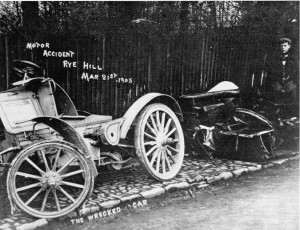
At his studio in Winchelsea Road he undertook work of all photographic aspects but his main interest was in producing post cards of local events. Among the best known of these were the shots of the fatal auto mobile accident on Rye Hill in 1905 and the subsequent military funeral.
Mr. Whiteman was the official photographer of the “Herald of Rye” a monthly magazine that was published in the town in 1898-99. This small publication, priced 2d., was edited by Harry Davis and ran to four editions.
Whiteman was especially good at scenic shots and pictures he produced after the exceptionally heavy snowfall in the winter of 1906 demonstrated his wonderful eye for beauty.
Ernest Whiteman must be classed as a local historian, not a man of words as were Holloway or Jeake but a pictorial genius who used all the equipment of his trade to record a record of Rye history as it happened.
The new century brought change to Rye and all the British Empire. The Victorian age passed but poverty was still rife and when unemployment or illness struck there were no welfare services to come to the rescue. Local generosity had to provide. An outstanding example was John Symonds Vidler. He organised the re-opening of the soup kitchen in the hard winter months of early 1907. The ex mayor’s generosity was unbounded, he provided most of the funds for food and fuel which gave sustenance to no less than 153 applicants. The soup kitchen was housed in the old water pumping building, now the toilets, at the top end of Rope Walk.
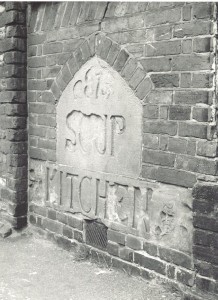
In those days of the early century, as indeed up to the 1970’s, Rye was led by its city fathers. Rye Council was all powerful and the men at the helm were people of substance and commanded respect because they were known by all and observed going about their town business. One such man was Henry John Gasson long time councilor and Mayor of Rye in 1903 and 1904. He was an able local politician and business man and was at the heart of many of the new reforms that were brought about in Rye in the years immediately following the end of the Victorian Era. His son H. J. Junior was Captain of the Fire Brigade. He led the Rye firemen when they fought the serious blaze at Colebrooks Mineral Factory at The Strand in 1907. The heat was so fierce that cylinders of Carbolic Acid exploded and were projected through the air with great force, one landing 200 yards away on the roof of a stable in Winchelsea Road.
Two more powerful personalities to hold the mayoralty during the first decade of the new century were Kingsnorth Reeve (1906-07) and Joseph Adams (1908-09). Walter Dawes held the position of Town Clerk through these years and beyond right up to 1925.
In 1900 St. Walburga’s Church was built in Watchbell Street and the ‘old faith’ returned to the town, not entirely without dissension. By 1910 however, with the arrival of Fr. Bonaventure it grew in strength in a more tolerant town.
The end of the first decade coincided with the death of William Dawes the Clerk of the Peace who died on Christmas day 1909. He was succeeded in office by Cuthbert Hayles, twice previously Mayor of Rye.
On May 6th. 1910 the Edwardian age came to a close, Edward VII had reigned for only ten years but the changes in Rye were very significant. An era of Peace had descended over the town and poverty was at last being seen as something that could be overcome.
George V Comes to the Throne
At the Coronation of King George V. Rye claimed her ancient right of attendance and Councillor J. Adams and Mr. Walter Dawes were present with other Barons of the Cinque Ports at Westminster Abbey on that momentous occasion.
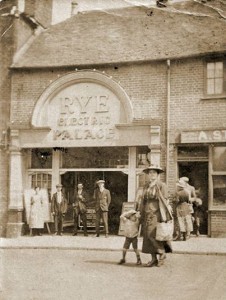
Moving Pictures came to Rye in 1910 when a licence for Chromatograph Exhibitions was granted to the Cinque Ports Assembly rooms. These shows were a great success and soon a purpose built Cinema was in operation in Landgate and the ‘wonder of the age’ became established in the town opening up the world in a way no medium had done before.
THE LAST YEARS OF PEACE
These were the years to enjoy, soon the sound of marching boots would herald the start of a war the like of which had never been seen. On March 13th. 1911 Captain E.J.Cory, founder of the Scouting Movement in Rye, died after a long 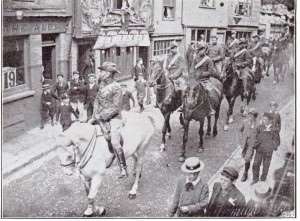 illness. He had a long and successful career in the Army, fighting in India and South Africa, where he was awarded the D.S.O. In 1902 he had taken on the job of commanding the Rye Troop of the Sussex Imperial Yeomanry, a group of volunteers similar to the territorials of today, he quickly raised their number to 27 men. They were the best shooting Troop in the squadron in their first year. The Sussex Yeomanty became the Royal Sussex Regiment in 1907 and the Rye men were E Company of 5th. Battalion. In 1912 they were given a new Drill Hall near the Windmill. Here they practised their skills of shooting and marching, they would soon be putting them to the test on the fields of Flanders.
illness. He had a long and successful career in the Army, fighting in India and South Africa, where he was awarded the D.S.O. In 1902 he had taken on the job of commanding the Rye Troop of the Sussex Imperial Yeomanry, a group of volunteers similar to the territorials of today, he quickly raised their number to 27 men. They were the best shooting Troop in the squadron in their first year. The Sussex Yeomanty became the Royal Sussex Regiment in 1907 and the Rye men were E Company of 5th. Battalion. In 1912 they were given a new Drill Hall near the Windmill. Here they practised their skills of shooting and marching, they would soon be putting them to the test on the fields of Flanders.
On July 7th. 1913 Town Clerk Walter Dawes was made an honorary Freeman of Rye in recognition of his 31 years service to the town. The Mayor, W. E. Colebrooke, presented him with a silver casket containing the resolution engraved on vellum. He became only the third freeman of the Borough to be elected under the act of 1885.
Plans were under way to extend the East Sussex Railway from Northiam to Rye, coming down the Tillingham Valley and Joining the South Eastern Line at a point a point near the Ferry Road crossing.
“Europe was plunged into the greatest and most bloody contest of all time.”
This scheme and another to move the Fire Station from the basement of the Town Hall to a new site were forgotten at midnight on August 4th. 1914, when in the words of Rye historian Leopold Amon Vidler “Great Britain declared war on Germany – and Europe was plunged into the greatest and most bloody contest of all time.”
The territorials of the 5th. Division (Rye), who were on their annual summer training camp, were immediately recalled and sent to Dover Castle, passing through Rye on the way, for some this would be the last time they would see their home town. The following Spring saw them heavily engaged in action at Richbourg where they suffered heavy losses. By this time the Ancient Town had mustered 300 able bodied men out of a population of 4000 to wear the King’s uniform and on top of this number 90 men, who were not eligible to join the regular Army because of disability or age, offered their services and became Number 4 Platoon 4th. Battalion Sussex Volunteers.
During these terrible times the Town’s officers kept things together as best as
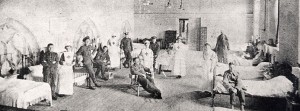
possible. Mayors Colebrooke and Burnham were a great inspiration and supported the many war orientated projects that were operated in those years. Two Hospitals for wounded soldiers were opened, one by Mrs. Jameson in the Convent in East Street.
Rye Harbour Bombed
In March 1915 there was an air raid on Rye Harbour. Three bombs were dropped and made large holes in the shingle, no other damage was done. There was speculation that the mouth of the Rother had been mistaken for the Thames and leaves one wondering what might have been the final destination of the Zeppelin crew if their navigation was that far out!
James Hessel was appointed Food Control Officer for Rye. The Middle Marsh was allocated as allotments. There was a lot of emphasis on the collection of waste paper for the war effort and Councillor Sherwood organised a campaign to this end and amassed vast quantities, an effort which was praised by the Corporation.
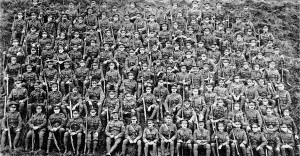
Of the five officers who led the 5th Batt.(Rye) Royal Sussex Regiment to war, four Capt. J.R.Ewing, Capt. A.A.Holmes, Capt. A.H.Knight and Lieut. AG Chapman, were dead, and the fifth, Captain Dawes was severely shell shocked and invalided out, all within three years. Private Frank Ashenden, an ex Rye Councillor, who had given up his business at the beginning of the war and was one of the early volunteers was killed in action with the 5th. Battalion and his name, along with 155 others, was inscribed on a War Memorial Cross erected in the Church Yard.
The “War to end all wars” came to a conclusion on the eleventh hour of the eleventh day of the eleventh month 1918. It left a mark on Rye that would not be properly healed before a new conflict came to re-open the old wounds.
The Roaring Twenties
The ‘twenties’ opened with a great feeling of optimism in the Town. Mayor J. L. Deacon led Rye from the dark days at the end of the War, he took office on 9th. November 1918, just two days before the Armistice was signed, and served for four years. His outgoing nature and ability to fit in at any social level made him the ideal man for the job. He was revered and respected by all and could converse with Lords or labourers with equal fluency. He attended every function in the Town, opening Bazaars, dancing at social gatherings, attending Church Parades and visiting neighbouring boroughs. He enjoyed every moment of it.
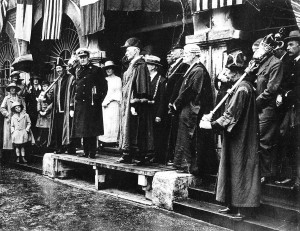
It was Mayor Deacon who in 1920 bestowed the honorary Freedom of Rye on Admiral of the Fleet Earl Beatty in recognition of of his eminent service during the Great War. Admiral Beatty went on to Rye Church where he unveiled a memorial in the North Chapel to his friend and comrade, the Late Sir George Warrender of Leasam..
Council Houses At Udimore Road
By 1921 twenty brand new council houses had been erected on Cadborough Field. They were let at a rent of 12/6 a week for those without a parlour and 14/6 for those with parlour.
The Rye & District Memorial Hospital, designed by Sir Reginald Bloomfield and built with money raised in the area and by a magnificent donation by Lady Mc. Llwraith on a site at the entrance to Leasam Lane, was officially opened on November 13th. 1921 by H.R.H. Princess Louise, Duchess of Argyll.
Vicar Howes Dies in Church
Vicar of Rye for 19 years, The Rev. A.P.Howes, preached a fine sermon in St. Mary’s on Sunday 14th. May 1922, returned to his seat and quietly passed away. He was succeeded by Cannon John Fowler.
The New Shepway Cross
Councillor Albert Truelove succeeded Jesse Deacon as Mayor in 1922. He attended the unveiling of the new Shepway Cross in August of that year by the Lord Warden at Shepway, the old meeting place of the Cinque Ports Confederation. “It was a brilliant day” wrote Leopold Vidler “A large and distinguished company were present. A lunch followed at which many eloquent speeches were delivered”.
Busy Road
During the summer of 1923 a census of vehicles was taken of the traffic using the road between Rye and Winchelsea. In six days 2,700 motor driven vehicles passed against a total of 400 horse drawn vehicles!
Popular local man John Harvey became Rye’s new Mayor in November 1924. By now it had become abundantly clear to all that the Great War had taken more than just lives, the enormous expense of that great conflict had left a heavy burden for all to bare. Times were indeed very hard.
One of the new Mayor’s first tasks was to receive the resignation of Walter Dawes, Rye’s Town Clerk since 1882. At 80 Mr. Dawes, whose Father, Grandfather and Great Grandfather had also held the position before him, handed on the post to his Son, Capt. Edwin Plomley Dawes who has been Assistant Town Clerk since 1912. Few families can have had a similar record of service to such an office in any Borough in the land.
John Harvey was a great Mayor. He was here there and everywhere, attending functions, meetings, Church Parades and doing all the jobs and more expected by one in his position. In the summer of 1925 he organised a celebration of Empire Day on The Salts for the children of Rye. An event which still lives in the memory of some of those that attended and are with us today. John Harvey also attended the Cinque Ports Brotherhood Guestling at Dover where he made by far the best speech of the day. Sadly the Mayor was terminally ill by this time, it was only his determination that carried him through to the end of his Mayoralty and he was not well enough to put himself forward for a further term of office. He died the Following May.
Alderman Burnham was Mayor of Rye for 1926, serving a year in the office as a peacetime incumbent, he had held the position during two of the darkest years in 1914 and 15.
A similar honour was bestowed on George Ellis who occupied the Mayoral Chair in 1917-18, he was nominated to serve again through the year of 1928. This coincided with ladies making their first appearance as Rye Councillors. Mrs. E. M. Hacking and Mrs. A. M. Roffey joined the Council as a result of being elected the previous November.
Leapold Amon Vidler
Every town has many family names that appear in important posts and are associated with important business ventures within the town. one of the more important such families over the last two hundred years in Rye must be the Vidlers. Leopold Amon Vidler was elected Mayor of Rye in November of 1927, following in the footsteps of his Father and Grandfather. He had served on the Council since leaving the Army in 1919 and was to prove one of the ablest Mayors in the History of the Ancient Town.
The historian in the man set him on a task of providing Rye with a Museum, this was achieved in a remarkably short time and with the able support of Councillor Sprigg Walker a museum was up and running in the Old Battery House within six months of Vidler’s appointment as Mayor.
Leopold Vidler was also instrumental in getting a League of Nations Union in Rye. Another event inspired by him was a revival of the ‘Beating the Bounds’ ceremony to demonstrate to the Rye Council and Officials the exact area within which they had jurisdiction. By all reports the event was more than eventful and involved wading ditches and streams and climbing fences and hedges. At the end of his first term he was persuaded to continue in office for a further year. He agreed, hoping it would be a ‘quiet year’ as his business commitments were demanding more of his time.
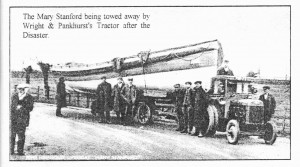
Six days later, on 15th. November 1928, the Rye Harbour Lifeboat ‘Mary Stamford’, returning from a rescue attempt in very rough seas, was overturned by the force of the waves within a stones throw of the Harbour Mouth. All seventeen of her brave crew were drowned in the raging surf before being washed ashore on the beach at the River Mouth. Alfred Homer, a young St. John’s Ambulance man (many years later to become Mayor of Rye himself) recalled that on that dreadful day he desperately worked trying to revive a chap that he had only a few days before been massaging for cramp at a Rye Football match.
To Mayor Vidler, the local Hon. Secretary to the Royal National Lifeboat Institution, fell the task of summoning medical aid, reporting to London and visiting the scene, seeing the lifeless bodies of the crew. He was closely involved in the opening of a Disaster Fund for the relief of the stricken depend-ants. Rye Harbour was such a small close knit community, every single home was touched by the tragedy. The Fund reached £20,000 in less than a week and was finally closed with a total of nearly £35,000 from a total of 12,000 contributors.
As can be expected Mayor Vidler’s second year of office was over shadowed by these terrible events and 1929 with the Wall Street Crash and all that went with it, was not the best of times to be in business. It must be recorded that despite the pressures that Leopold Vidler must have been under during these trying times he proved to be a fine Mayor. His efforts for Rye did not finish at the end of his Mayoralty he went on to write ‘A New History of Rye’ a publication of brilliant description and accuracy from which many of the facts included here have been drawn.
Into the Thirities
Rye Characters of the Thirties are easier to write about. They feel more tangible and as it were, in reach. To those of us who were born in the Town and grew up here, the thirties are within memory or at least our parents memory. We have heard stories and accounts of events of those times at first hand and a structure is held in our minds similar to an artists frame, all we need are a few pictures to fill it.
Alderman Joseph Molyneux Jenkins followed Leopold Vidler into the Mayoral seat and held office from 1929-34. Molyneaux Jenkins was Headmaster at Rye Grammar School and a Justice of the Peace. His organised commanding stature carried Rye through the recession years after the Wall Street Crash.
Business in Rye soon picked up and by 1933 the High Street was trading at a respectable level. Some of the well known names were gone but most had survived and were joined by new traders who soon established themselves. Among the old and new were Deacon’s Printing Works, Candler the Tobacconist, Goulden’s Library, Prebble the Auctioneer and Estate Agent, Ellis Bros. the Ironmongers, Adams & Son Printers, Ashbee the Butchers, George Cade the Ladies and Gentleman’s Tailor, Albert Truelove the Draper and George Farr Watchmaker, Jeweller, Silversmith and Optician.
The Town was rich in Sports Clubs and Societies during these pre- war years boasted a Football Club, Cycling Club, Sailing Club, two Tennis Clubs, Golf Club, Hockey Club, Bowls Club, Chess Club, Cricket Club, Athletic Club, Angling Society, Badminton Club and of course, The Rye Sports Committee which arranged the Annual Rye Sports Festival on Bank Holiday Monday.
An Ambulance was presented to Rye Memorial Hospital by Lady Mcllwraith and loaned to the Ambulance Association. The vehicle was housed at the premises of Wright & Pankhurst in Tower Street and could be called upon by ringing their telephone number Rye 32.
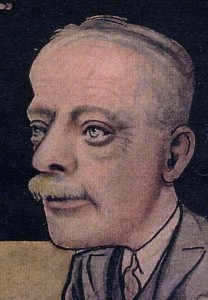
At the end of 1934 the author Edward Frederick Benson became Mayor of Rye. E.F.Benson already renowned as a fine author, first came to Rye in 1900 to visit Henry James at Lamb House. He became a frequent visitor to the town, staying at Lamb House or with Lady Maud Warrender at Leasam House, a fine country mansion overlooking the Town. It was Leasam House he used as a setting for his novels ‘Colin’ and ‘Colin 2’. His best known works are the Mapp & Lucia series of books which are set in Rye. Benson used the name Tilling’. The books were later turned into a television series many scenes of which were shot in the Town.
Benson served three terms as Mayor and took to the task with enthusiasm. He enjoyed the job and Rye enjoyed him. He was a generous benefactor to the Town. He paid for the renovation of the Organ in St. Mary’s Church. The massive stained glass west window in the Church was presented by Benson in honour of his parents and the North window in memory of his Brother. The Look-Out on Hilder’s Cliff overlooking The Salts was his gift to the Town. In 1938 he was made a Freeman of the Borough. Benson died in 1940 and is buried in Rye Cemetery. The E.F.Benson Society was formed to preserve his legacy and promote his works. It still flourishes today.
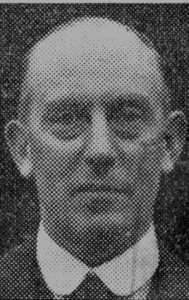
Councillor George Marsden was next to hold the Mayoral office. He enjoyed the last years of peace but was called away in the dark Days of 1940 on ‘vital war work’. His family moved away with him and they were never again seen in Rye. Deputy Mayor, Councillor Joe Cooper took over as the The Battle of Britain raged overhead. The German War Machine was ranged against us along the Belgian and French coasts. The town suffered bombing raids resulting in deaths and much damage, It was a busy time for Rye Council but Mayor Joe Cooper was made of stern stuff and led the town through this dangerous period of it’s history.
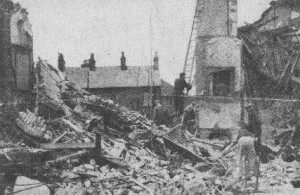
The new Junior Infants School had been opened shortly before war came. It carried on throughout most of the hostilities although very depleted at times by the evacuation of most children. Rye Grammar School evacuated in its entirety, to Bedford.
Joseph Cooper steadied the ship through 1941 and into 1941, He was followed by Edward Gurth Wace,. These two gentlemen had the onerous task of dealing with the many local restrictions and regulations that were imposed in ever increasing number throughout the duration of the War. When the War ended it seems that Rye followed the pattern taken after the Great War in the case of Joseph Cooper.
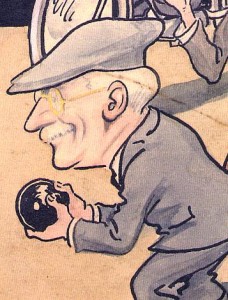
He was elected for a peacetime year of office 1946. Cooper Road on the Tilling Green estate carries his name in respect of his efforts to get the whole post war housing project started.
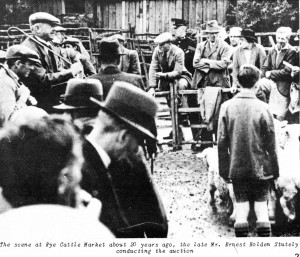
Popular Estate Agent and Auctioneer Ernest Holden Stutley became Mayor of Rye for the three years 1947,48 and 49. These were eventful times with lots of War damage to repair and small funds to achieve it all with. The Health Service was introduced and free medical attention for all became a reality. Rye Small Cottage Hospital with its brilliant Surgeon Mr. Button catered for the Town. Dr. Manmngton, a local practitioner was also a well loved figure in the community and very involved with his patients. In fact all Rye Doctors of the time were very well spoken of. Dr. Hartley, Dr. Parks, Dr. Palmer and Dr. Townsend were all in local practice at about this time.
Good Fun in the Fifties
The decade of the fifties would be many peoples choice if they could go back in time. These were the times when prices held stable, petrol was two shillings a gallon, motoring and pedal cycling were fun and there were not too many people about. The War was becoming a memory, new things were becoming available in the shops. Television, with programmes running for just two hours a night at the beginning but featuring great sporting events like the Stanley Mathews Cup Final. The 1951 festival of Britain captured the imagination of the country and summers were hot, winters cold and milk came in bottles as nature intended.
Popular Harry Schofield was Mayor for 1950 and he was followed in 51 & 52 by Reginald Prebble the Estate Agent. Frank Clarke’s Barber Shop in Rye High Street was packed every day of the week. It became an exchange centre for local information. Frank was President and driving force of the Rye Sports Day Committee which arranged the Annual August Bank Holiday Cycling and Athletic Meeting on the Cricket Salts. A tall upright man who enjoyed being Chief Starter, he was a mine of information on all sporting matters. At that time the Sports and Carnival were linked, the Carnival Procession following the sporting events.
These were the days of the giant Bonfire Celebrations on the Fifth. The days of great Bonfire Boys like Frank Taylor, Gerry Bellhouse, Donald Deeprose, Charlie Tomlin, Alf Homer, Frank Hall, Tony Hayward, Bessie Deeprose, Ernie Odell, Bobby Edwards and many more. The days when a Burning Boat and a Fire Breathing Dragon, designed and built by Gerry Bellhouse, were included in a vast cavalcade of floats in procession around the town. One wonders how today’s officialdom would have coped with all this. How many remember the Bonfire Boys Song written by Frank Taylor and performed to the tune of Sussex By The Sea? When we march along Cinque Ports Street, doors and windows open wide ….
David Chandler. Maurice Beevers and Geoffrey Bagley filled the Mayoralty for the remainder of the fifties each serving for two years. Maurice Beevers was the popular Headmaster of the Primary School in Ferry Road and proved to be an excellent Mayor.
Geoffrey Spink Bagley was in the mould of Leapold Vidler being an avid historian, especially on matters concerning Rye and the Town Museum. Like Vidler he was later to produced a fine book about the Town called ‘The Book of Rye’ among many other smaller booklets relating to the Town’s history.
The Swinging Sixties
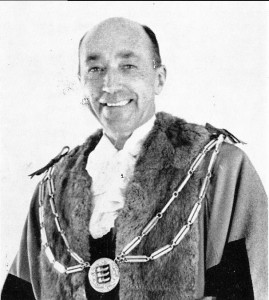
The new Decade opened with Alfred Horner in the Mayoral seat. Alf was a true Ryer in all senses of the word. He loved the Town but more than that, he loved the people of Rye. He had a Grocery shop in Landgate. Alf was involved in many Rye Clubs and Societies, even before he became Mayor but during his Mayoralty he became associated with every single organisation in the Borough, opening Fete’s, presenting Prizes and attending social events virtually every day he was in office. It would probably be true to say, despite the qualities and achievements of the many fine Mayors this Town has produced, that Alfred Horner was the most popular Mayor of Rye in living memory.
The Town moved into an era of prosperity in the early sixties. New things coming onto the market all the time. The Space Age was here. Spin-offs from the Space programme were making their mark. Transistor Radios, Tape Recorders and many other consumer products never available before came along and made the world a faster place to live in.
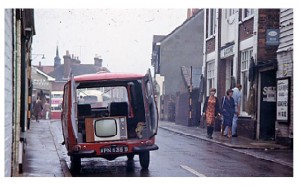
Rye High Street prospered and when a General Market was introduced on Thursdays at the Cattle Market site near Rye Station the Town really began to buzz. At this time Rye attracted a huge following from the surrounding district. The main shopping was done on a Saturday and the numerous Grocery, Green Grocery, Butchers, Clothes, Electrical and service shops in the Town overflowed with stock. Everything could be obtain in the town. The peak of the boom came around 1965.
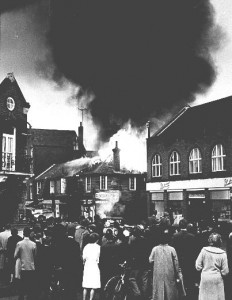
In 1961 there was a devastating fire at the Central Garage in Cinque Ports Street. Rye’s part time firemen, led by Fire Chief Bourne were quickly on the scene as the fire, which had started when the petrol bowser was actually filling the garages petrol tanks, took a firm hold. The danger of a catastrophic explosion that could have wrecked half the Town was averted by acts of heroism on the part of the fire fighters. The tyre store over the car showrooms was a raging inferno and two cottages behind the garage were quickly ablaze and burned to the ground. Fire Chief Bounie directed the main efforts around the storage tank fillers, if the tank had ignited the resulting explosion would have claimed many lives. Bob Rogers, a fourteen year old lad at the time, rescued his canary from one of the blazing cottages and as a direct result of his experiences he decided he wanted to be a Fire Fighter. As soon as he was old enough he joined Rye’s part time force as the Town’s youngest Fireman. Today he is still fighting fires with the Rye team.
Ron Reynolds became Mayor for 62 and 63. Another popular figure who had played his part in the Town’s activities. He had been a member of the prewar Rye Wheelers and became an active member of Rye Movie Society, appearing in two of their Award Winning Films. He was followed by William Macer, a well known grocer in the High Street.
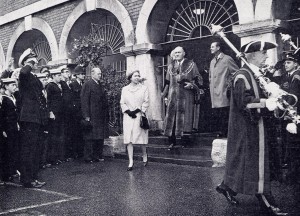
Then came the very dignified Alderman William Hacking, a local farmer and well known Point-to-Point owner and jockey. He and his Mayoress Mrs. Hacking were the ideal couple to greet the Royal Party on the occasion of The Queen’s visit to Rye in 1966. The Hackings contributed a lot towards making the day the great success it was.
New Police Station
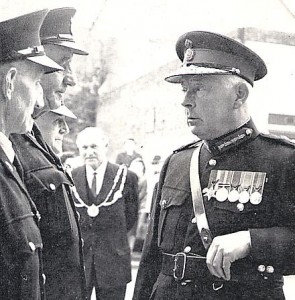
The Police moved their Headquarters from Church Square to a brand new purpose built building in Cinque Ports Street. Rye had never been so well policed. Sgt. Crew introduced a ‘Crime Desk’ feature into Rye’s Own which proved a, great success. Sgt. Sheppard, still living in the Town, P.C.Hunt and P.C. Barefoot were some of the Rye ‘Coppers’ of the sixties. They all seemed to be known to the public by name then, how many can you name now?
Badger Gate was opened, a sensible development for senior citizens where they
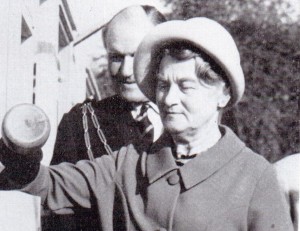
could be completely independent yet had the security of a Warden on call at the touch of a bell. Geoffrey Scotcber had a large hand in the planning of the project and the Mayoress at the time, Mrs. Hacking suggested the name.
The Sixties were the heyday of The Rye & District Movie Society, known affectionately as the Cine Club. During the decade they won no less than four Inter-Club Film Competitions. They kept a marvellous record of the times, covering all the important events in the Town including the Royal Visit and all the Bonfire Celebrations, Carnivals and Sports

Days of the period. Guests Nights and Public Film Shows were always a great success and so many people attended the Showing of the Royal Visit film made by the Club, there had to be three separate showings in the large Hall at the Thomas Peacock School. There were some very talented members including Jeffrey Waters, Joan Munn, Roy Miles, Clive Wall, Fred Masters, Joan Camier, Bert Relf, Roy Parrack, Tony Knight, Bill Beeson, David Smeed, Pauline Morris, Maureen Allen and many many more. It seems a pity that with the introduction of Video Cameras the Cine Camera became obsolete and the Movie Society faded away The Sixties were a time of great and exciting changes. Elvis Presley, Cliff Richard and The Beatles had changed the music scene, Carnaby Street had moved the fashion centre of the World from Paris to London and England won the World Cup. Rye was fortunate indeed to have had a cross section of capable people to steer the Ancient Town in the right direction.
Mayor Phil Ellis took Rye out of the Sixties and into a new decade. He was a great character coming from an old Rye family with a Liberal tradition. His ironmongers shop at the east end of the High Street had been the family business for many years. Phil took an interest in all things ‘Rye’ and was ideally suited to represent the town in the Mayoral Seat which his Father, George Ellis J.P. had occupied in 1916 and 1926.
The Raving Seventies
The Seventies opened badly. Decimalisation was the first setback. Buns which cost 3d. suddenly became 3p. an increase of 250%. It seemed to happen to all goods which cost just a few pence. Most were too confused to complain and when the realisation dawned it was all to late. On a brighter note Rye had its first lady Mayor when Councillor Mrs. Elsie Philpott served for two years 70-71.
Dr. Alex Vidler, relation of Leapold Amon Vidler, took the Mayoralty for the following two years and so carried on a family tradition.
Doom and Gloom followed. A massive shortage of oil caused by the Vietnam War trebled the price of fuel in a very short space of time. “Rye’s Own” had a ‘world exclusive’ when it broke the news of the impending shortages.
Then along came ‘renationalisation’ when Rye Council lost all powers save advisory and the control of local footpaths. This was a bad day. Now power over local affairs rested with The Rother District Council. Rye was to be governed not by the locally elected body but by a group of people dominated by District Councillors from Bexhill, over whom our two local District Councillors had little influence. This was a bad day for ‘local government’ and a sad day for Rye.
Terry Spencer filled the Mayoral office for 74-75. A Physical Training Instructor and school teacher, Terry was very popular with young people and was actively involved in local sport. He also became a District Councillor an.d made valiant efforts to put Rye’s case forward on any amount of issues.
Henry for Everest followed He was an active member of the Rye Community Centre Committee and helped guide the new facility through its first years. He was also prominent in the fight to save the Hastings – Ashford Line from the Beeching axe
Joan Yates became Rye’s second woman Mayor. 1977, Silver Jubilee year and 1978 were two very busy years for this popular hard working lady who very much enjoyed her period in office.
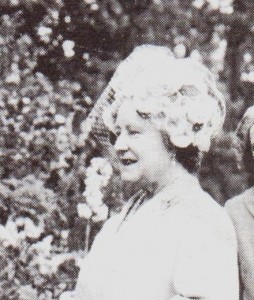
Another lady mayor followed when Jo Kirkham took the helm. Her three year tenure was highlighted by the visit of the Queen Mother on the occasion of Her Majesty’s eightieth birthday in 1980.
William (Bill) Simpson, a retired policeman came next. Two years as Mayor of Rye in the early eighties when the boom times were just beginning to take effect and Rye was being swept along with the tide was a time to have a steady hand on the wheel. Mayor Simpson did a good job.
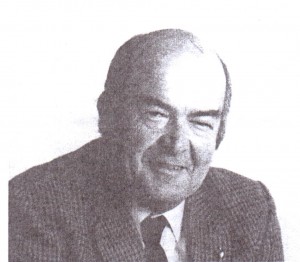
Son of Rye, Roger Breeds was next to take the mayoral robes. His namesake John Breeds the butcher already resided in the Town Hall but for entirely different reasons. It can safely be said that Mayor Roger completely vindicated the name Breeds with his good works over the ‘84-’85 period.
Equality of the sexes has certainly been achieved in Rye, especially in the mayoral seat. Monica Oliver, well known for her social and charity work, became the town’s mayor for 1986-87. These were boom times indeed and the town was prospering as never before. All kinds of development and business ventures were taking place. Property prices soared. In the words of an illustrious former Prime Minister “You never had it so good!” The bubble was soon to burst.
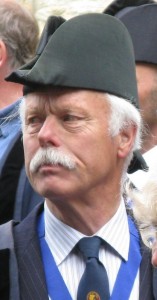
Frank Palmer, a man with long family connections in Rye and Romney Marsh brought caution and dignity to the office when he took his mayoralty in 1988. A man deeply interested in Rye’s past and preserving the history of the town. It was fitting indeed that he should hold office at a time Rye’s 700th. year of mayoralty came around in 1989.
June 1989 saw the opening of the Rope Walk Arcade Shopping Centre. This unique collection of over thirty shops under one roof was the brainchild of Bill Waters, who assisted by brother Chris, created an environment which has enabled many local would be shopkeepers a chance to start a business without too much financial outlay or risk. Many have achieved their dream.
The boom bubble burst in August 1989. Property prices began to tumble. Some home owners found themselves in a negative equity situation. Purse strings were tightened. Business soon felt the pinch. Many went to the wall. In Rye the effect was gradual but job losses soon affected many families.
Slow Recovery in the Nineties
The early nineties were hard. There seemed to be a double standard operating. Those who had regular employment, especially civil servants, went on enjoying the good life. Others not so fortunate found they-were leading an entirely new life, virtually in poverty in contrast to what they had been used to. This effect was as evident in Rye as anywhere else in the country.
George Shackleton became mayor. A good steady local chap who understood the problems some Rye people and businesses were suffering. There are many stories of how he used his influence to help during those difficult times.
Rye grocer, John Ciccone was next to serve, he was mayor during ‘92 and ‘93 followed by teacher Robert Beckwith for ‘94 and ‘95. By now the worst of the recession was over and things were improving on the high street.
Charles James, a firefighter from London served through 1996-97 and then, for one year only, Paul Carey a local man and long serving Bonfire Boy, put his back to the wheel and got people focusing on local affairs again. Paul’s year in office brought back memories of some of the great Borough Mayors and rekindled interest in an office which, in those old pre1972 days, had teeth. Paul put a bit of the bite back into Rye’s Mayoral seat.
Geraldine Bromley became Rye’s last mayor of the century. Geraldine has always shown great interest in tourism and is the ideal person to guide Rye into a new Millennium that promises great developments in that field. Rye must keep up with the Tourism Tide if she is to prosper in the new age to come.
My Choice for 25 of the Top People and Characters of Rye 1900-1999
Cannon John Williams – Alfred Homer – J.H. Gasson – Father Richard
Jeffrey Waters – Capt. E.J. Coty – Ernest Whiteman – Phil Ellis
Leapold Amon Vidler – Joseph Adams – E.F. Benson – John Symonds Vidler
J. L. Deacon – Jim Foster – Walter Dawes – Dr. Button – Stan Bourne
Dr. Manmngton – John Harvey – Frank Clarke – Maurice Beevers
Fire Chief Bourn – Fred Masters – Ernie Odell – Roy Miles – William Hacking
From the Millennium Issue of Rye’s Own Jan 2000
All articles, photographs and drawings on this web site are World Copyright protected. No reproduction for publication without prior arrangement.